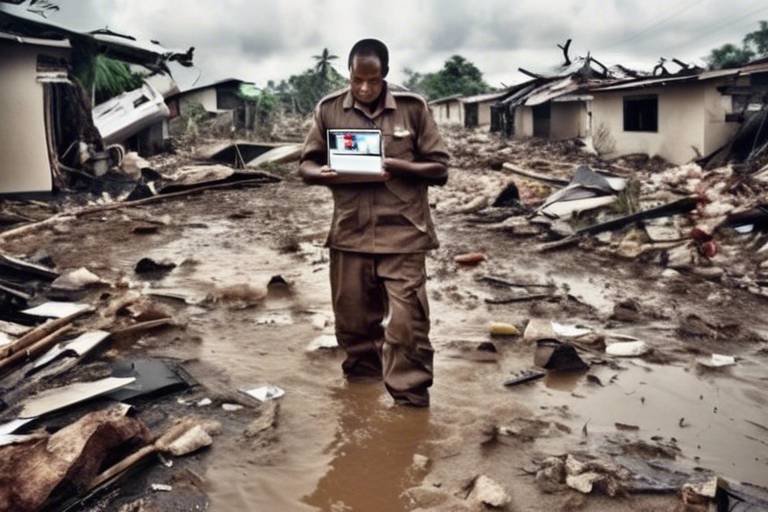Understanding How Climate Change Affects Public Health
Climate change is not just an environmental issue; it’s a profound public health crisis that we can no longer ignore. As the planet warms and weather patterns shift, the impacts on human health are becoming increasingly evident. From extreme weather events to deteriorating air quality, the ripple effects of climate change can be felt in our hospitals, communities, and daily lives. Have you ever considered how a hurricane or a heatwave might not just disrupt your day but could also lead to long-term health issues? These events can cause injuries, exacerbate existing mental health problems, and even lead to increased mortality rates. Understanding these risks is crucial for effective public health planning and response.
Extreme weather events are becoming more frequent and severe due to climate change. Hurricanes, floods, and heatwaves can lead to a range of health risks. For instance, during a hurricane, people may suffer from physical injuries, while the aftermath can trigger mental health issues such as anxiety and PTSD. The stress of losing one’s home or loved ones can be overwhelming. Moreover, heatwaves can lead to heat exhaustion and heatstroke, particularly in vulnerable populations like the elderly and those with pre-existing health conditions. It’s essential to recognize these risks and prepare our healthcare systems to respond effectively. Understanding the potential health impacts of these events can help communities develop strategies to protect their residents.
Another significant impact of climate change is on air quality, which has direct implications for respiratory health. As temperatures rise, so do levels of air pollution, exacerbating conditions such as asthma and chronic obstructive pulmonary disease (COPD). The relationship between climate change and air quality is a vicious cycle: higher temperatures can lead to increased emissions from vehicles and industries, which in turn deteriorates air quality. This is where the connection becomes critical—poor air quality not only affects those with existing respiratory issues but can also lead to new cases of respiratory diseases among the general population. We must prioritize improved air quality management to safeguard public health.
Wildfires, often intensified by climate change, release a cocktail of harmful pollutants into the air. These pollutants can travel long distances, affecting individuals far from the fire's origin. The smoke contains fine particulate matter that can penetrate deep into the lungs, aggravating respiratory conditions such as asthma and bronchitis. Vulnerable groups, including children, the elderly, and those with pre-existing health conditions, are particularly at risk. It's essential to understand the health implications of wildfire smoke and implement strategies to protect these populations during wildfire season.
When it comes to air quality, not everyone is affected equally. Certain demographics, including children and the elderly, are more susceptible to the adverse health impacts of poor air quality. Children’s lungs are still developing, making them more vulnerable to pollution. Similarly, older adults may have compromised respiratory systems or other health issues that make them more sensitive to air quality changes. Targeted interventions, such as providing clean air shelters during high pollution days, can help protect these vulnerable groups and reduce health disparities.
Chronic exposure to air pollution can lead to serious long-term health issues, including cardiovascular diseases. Studies have shown that long-term exposure to poor air quality can increase the risk of heart attacks and strokes. The implications are staggering: as air quality deteriorates due to climate change, we may see a rise in chronic health conditions that burden healthcare systems and affect quality of life. It's crucial to address these issues now to prevent future health crises.
Shifts in climate patterns are altering the distribution of vector-borne diseases, such as malaria and dengue fever. Rising temperatures and changing precipitation patterns create favorable conditions for mosquitoes and other vectors to thrive. This is not just a problem for tropical regions; as the climate changes, these diseases are spreading to new areas, putting more populations at risk. Understanding how climate change affects the spread of these diseases is vital for public health planning and response.
Climate change also poses a significant threat to food security, impacting agricultural productivity and nutritional quality. As weather patterns shift, crop yields can fluctuate dramatically, leading to food shortages and increased prices. This situation can have dire consequences for public health, particularly for communities that rely on stable food supplies. Poor nutrition can lead to a host of health problems, from stunted growth in children to increased susceptibility to chronic diseases in adults. Addressing these issues requires a concerted effort to promote sustainable agricultural practices that can withstand the changing climate.
Changing weather patterns are affecting crop yields globally. Droughts, floods, and unpredictable weather can lead to reduced agricultural output, threatening food security and nutrition. For instance, farmers may struggle to produce enough food to meet demand, leading to increased prices and reduced access to nutritious foods. These changes can have a cascading effect on public health, as food insecurity can lead to malnutrition and associated health issues. It’s crucial for policymakers to consider these impacts when developing strategies to combat climate change.
Implementing sustainable agricultural practices can help mitigate the health impacts of climate change. Techniques such as crop rotation, organic farming, and agroforestry can enhance resilience against climate variability. These practices not only improve food security but also promote better nutritional outcomes for communities. By investing in sustainable agriculture, we can build healthier populations and mitigate the adverse effects of climate change on public health.
- How does climate change affect mental health? Climate change can lead to increased anxiety, depression, and PTSD due to extreme weather events and the stress of adapting to changing environments.
- What can individuals do to help mitigate these health impacts? Individuals can reduce their carbon footprint by using public transport, conserving energy, and supporting sustainable practices in their communities.
- Are there specific health policies that can address these issues? Yes, policies aimed at improving air quality, enhancing disaster preparedness, and promoting sustainable agriculture are crucial in addressing the health impacts of climate change.

Health Risks from Extreme Weather Events
Extreme weather events, such as hurricanes, floods, and heatwaves, are becoming increasingly common due to climate change. These events not only wreak havoc on infrastructure but also pose significant health risks to individuals and communities. The impact of these disasters can be devastating, leading to injuries, fatalities, and long-term psychological effects. It's crucial to understand these risks to develop effective public health strategies and response plans.
When we think about extreme weather, our minds often jump to the immediate physical dangers—like the risk of drowning in a flood or getting injured during a hurricane. However, the health implications extend far beyond the initial chaos. For instance, after a disaster, communities may face a surge in mental health issues, such as anxiety, depression, and post-traumatic stress disorder (PTSD). These psychological impacts can linger long after the physical damages have been repaired, affecting the overall well-being of the affected populations.
Moreover, the mortality rates during extreme weather events can spike dramatically. According to the World Health Organization (WHO), heatwaves alone are responsible for thousands of deaths every year, particularly among vulnerable populations like the elderly and those with pre-existing health conditions. The table below summarizes some of the health risks associated with various extreme weather events:
| Extreme Weather Event | Health Risks |
|---|---|
| Hurricanes | Injuries, fatalities, mental health issues, waterborne diseases |
| Heatwaves | Heat exhaustion, heatstroke, exacerbation of chronic illnesses |
| Floods | Injuries, drowning, spread of infectious diseases, mental health issues |
| Wildfires | Respiratory problems, skin irritations, mental health issues |
In addition to these direct health risks, extreme weather events can disrupt healthcare services, making it difficult for individuals to access necessary medical care. Hospitals may be overwhelmed with patients, and supply chains for medications can be interrupted. This disruption can lead to worsening health outcomes for those with chronic conditions who rely on consistent medical care.
Furthermore, the aftermath of extreme weather events often leads to environmental changes that can have lasting health consequences. For instance, flooding can result in contaminated water supplies, leading to outbreaks of diseases such as cholera and leptospirosis. The psychological toll of these disasters can also lead to increased substance abuse and domestic violence, creating a cycle of health risks that can persist for years.
As we look to the future, it’s vital for public health officials and policymakers to prioritize the development of comprehensive disaster response plans that address both the immediate and long-term health risks associated with extreme weather events. This includes improving mental health support, ensuring access to medical care, and implementing community resilience strategies. By understanding the intricate relationship between climate change and public health, we can better prepare for and mitigate the impacts of these increasingly common disasters.
- What are some common health risks associated with extreme weather events? Extreme weather events can lead to injuries, fatalities, mental health issues, and the spread of infectious diseases.
- How can communities prepare for the health impacts of extreme weather? Communities can prepare by developing disaster response plans, improving mental health support, and ensuring access to medical care.
- Why are vulnerable populations more at risk during extreme weather events? Vulnerable populations, such as the elderly and those with chronic health conditions, are more susceptible due to their physical limitations and reliance on consistent medical care.

Air Quality and Respiratory Health
Climate change is not just a buzzword; it's a real threat that significantly impacts our air quality and, consequently, our respiratory health. As temperatures rise, the atmosphere becomes a breeding ground for pollutants that can wreak havoc on our lungs. Imagine stepping outside on a hot summer day, only to find the air thick with smog and allergens. It's not just uncomfortable; it's dangerous. Poor air quality has been linked to a host of respiratory issues, including asthma, chronic bronchitis, and even lung cancer. The connection between rising temperatures and pollution levels is alarming and necessitates urgent attention.
One of the most concerning aspects of this issue is the interplay between climate change and air pollution. For instance, higher temperatures can lead to an increase in ground-level ozone, a harmful pollutant that exacerbates respiratory conditions. When the sun shines on pollutants from cars, factories, and other sources, it creates ozone, which can irritate the airways and make it difficult to breathe. This is particularly troubling for those with pre-existing health conditions, the elderly, and young children who are still developing their lungs.
Another significant factor in the degradation of air quality is the increase in wildfires, which have become more frequent and intense due to climate change. Wildfires release a cocktail of harmful pollutants, including particulate matter and carbon monoxide, into the air. These pollutants can travel hundreds of miles, affecting air quality far beyond the immediate vicinity of the fire. Studies have shown that exposure to wildfire smoke can lead to increased hospital visits for respiratory issues, particularly among vulnerable populations such as the elderly and those with pre-existing conditions. The smoke can linger in the air for days or even weeks, creating a persistent health hazard.
It's essential to recognize that not everyone is equally affected by poor air quality. Certain demographics are at a heightened risk, including:
- Children: Their lungs are still developing, making them more susceptible to the harmful effects of air pollution.
- The Elderly: Older adults often have pre-existing health conditions that can be exacerbated by poor air quality.
- Individuals with Respiratory Conditions: Those suffering from asthma or chronic obstructive pulmonary disease (COPD) are particularly vulnerable.
Targeted interventions are crucial for these groups to mitigate the health impacts of deteriorating air quality. For example, community health programs that focus on educating families about air quality alerts can empower them to take precautions when pollution levels rise.
Chronic exposure to air pollution can lead to lasting health issues, including cardiovascular diseases and reduced lung function. It’s like a slow poison; you may not feel the effects immediately, but over time, your health deteriorates. Studies have shown that long-term exposure to polluted air can lead to a 20% increase in the risk of heart attacks and strokes. The implications for public health are staggering, and the need for improved air quality management has never been more urgent.
In conclusion, as climate change continues to influence air quality, the health of millions hangs in the balance. It's imperative that we take action—not just for ourselves but for future generations. By understanding the intricate relationship between air quality and respiratory health, we can better prepare ourselves and our communities for the challenges ahead.
Q: How does climate change impact air quality?
A: Climate change leads to higher temperatures, which can increase the levels of ground-level ozone and other pollutants, worsening air quality.
Q: Who is most at risk from poor air quality?
A: Vulnerable populations include children, the elderly, and individuals with pre-existing respiratory conditions.
Q: What can be done to improve air quality?
A: Implementing sustainable practices, reducing fossil fuel use, and increasing green spaces can help improve air quality.

Impact of Wildfires on Respiratory Conditions
Wildfires have become an alarming reality in many parts of the world, and their impact on public health is profound, particularly regarding respiratory conditions. When wildfires rage, they release a cocktail of harmful pollutants into the air, including particulate matter, carbon monoxide, and volatile organic compounds. These pollutants can travel long distances, affecting air quality far from the fire's location. Imagine breathing in smoke that has traveled hundreds of miles—it's like inhaling the remnants of a campfire, but on a much larger and more toxic scale.
Research has shown that exposure to wildfire smoke can exacerbate pre-existing respiratory conditions such as asthma and chronic obstructive pulmonary disease (COPD). For individuals with these conditions, even short-term exposure to smoke can lead to increased hospital visits, emergency room admissions, and in severe cases, even death. The American Lung Association reports that during wildfire seasons, hospitals often see a spike in respiratory-related cases, highlighting the urgent need for awareness and preparedness.
Furthermore, it's not just those with pre-existing conditions who are at risk. Healthy individuals can also experience significant health effects from wildfire smoke. Symptoms may include:
- Coughing and throat irritation
- Difficulty breathing or shortness of breath
- Worsening of asthma symptoms
- Increased respiratory infections
Children and the elderly are particularly vulnerable. For children, whose lungs are still developing, exposure to smoke can lead to long-term health issues. The elderly may have weakened immune systems, making them more susceptible to the adverse effects of poor air quality. The intersection of climate change and public health is starkly evident here; as wildfires become more frequent and intense due to rising temperatures and prolonged droughts, the health implications for these vulnerable populations are dire.
Moreover, the psychological impact of wildfires cannot be overlooked. The anxiety and stress associated with evacuations and the loss of homes can lead to mental health issues, which in turn can exacerbate physical health problems, creating a vicious cycle. The smoke itself can also cause confusion and irritability, further complicating the situation for those affected.
In summary, the impact of wildfires on respiratory conditions is a significant public health concern that requires immediate attention. With climate change fueling more frequent and severe wildfires, communities must prioritize strategies to protect vulnerable populations, improve air quality management, and raise awareness about the health risks associated with wildfire smoke. After all, as the saying goes, "An ounce of prevention is worth a pound of cure." By taking proactive steps now, we can mitigate the health impacts of wildfires and safeguard the well-being of our communities.
- What are the immediate health effects of wildfire smoke?
Wildfire smoke can cause coughing, throat irritation, and difficulty breathing. Those with pre-existing respiratory conditions may experience worsened symptoms. - Who is most at risk from wildfire smoke?
Vulnerable populations, including children, the elderly, and individuals with pre-existing respiratory or cardiovascular conditions, are at the highest risk. - How can I protect myself during wildfire season?
Stay indoors, use air purifiers, and wear masks if you must go outside. Keeping windows and doors closed can also help reduce smoke exposure.

Vulnerable Populations at Risk
When it comes to the impacts of climate change on public health, not everyone is affected equally. Vulnerable populations, including children, the elderly, and those with pre-existing health conditions, face a higher risk of suffering from the adverse effects of climate-related issues. Imagine a delicate flower struggling to survive in a harsh storm; this is akin to how these groups navigate the challenges posed by climate change. Their biological vulnerabilities and socio-economic factors often leave them less equipped to cope with the escalating health risks.
For instance, children are still developing, making them particularly susceptible to environmental toxins and respiratory issues. Similarly, the elderly often have weakened immune systems and may already be battling chronic health conditions, rendering them more vulnerable to extreme weather events and poor air quality. Additionally, marginalized communities, including low-income families and racial minorities, frequently live in areas with higher pollution levels and fewer healthcare resources, exacerbating their risk.
To better understand the demographics at risk, consider the following table that highlights the various vulnerable groups and their specific health challenges:
| Population Group | Health Challenges |
|---|---|
| Children | Respiratory diseases, developmental issues |
| The Elderly | Cardiovascular diseases, weakened immune systems |
| Low-Income Families | Lack of access to healthcare, poor nutrition |
| Racial Minorities | Higher exposure to pollutants, limited healthcare access |
It’s crucial to implement targeted interventions that specifically address the needs of these vulnerable groups. For example, community-based programs that focus on improving air quality in low-income neighborhoods can significantly reduce health disparities. Furthermore, educational campaigns aimed at raising awareness about the risks of climate change can empower these populations to take proactive measures to protect their health.
In conclusion, recognizing and addressing the vulnerabilities of specific populations is not just a matter of equity; it is a necessity for effective public health planning. By focusing on these groups, we can develop strategies that not only mitigate the impacts of climate change but also foster resilience and improve health outcomes for everyone.
- What are the most vulnerable populations affected by climate change? Vulnerable populations include children, the elderly, low-income families, and racial minorities, who face heightened health risks from climate-related issues.
- How does climate change affect air quality? Climate change can lead to increased temperatures and extreme weather, which in turn can worsen air quality and exacerbate respiratory conditions.
- What can be done to protect vulnerable populations? Targeted interventions, community-based programs, and educational campaigns can help mitigate the health impacts of climate change on vulnerable groups.

Long-term Effects of Air Pollution
When we think about air pollution, we often focus on the immediate discomfort it causes—like coughing or sneezing. However, the long-term effects can be far more insidious and dangerous. Chronic exposure to polluted air can lead to a myriad of health issues, especially for those who are already vulnerable, such as the elderly or individuals with pre-existing health conditions. Over time, the air we breathe can become a silent assassin, contributing to serious diseases that can alter our lives forever.
Research has shown that long-term exposure to air pollution is linked to a variety of health problems, including:
- Cardiovascular Diseases: Polluted air can damage the heart and blood vessels, leading to conditions such as heart attacks and strokes.
- Respiratory Issues: Chronic obstructive pulmonary disease (COPD) and asthma can worsen over time due to continuous exposure to harmful pollutants.
- Cancer: Certain air pollutants are classified as carcinogens, increasing the risk of lung cancer and possibly other types of cancer.
- Neurological Disorders: Emerging studies suggest a link between air pollution and neurodegenerative diseases like Alzheimer's and Parkinson's.
To illustrate the gravity of these long-term effects, consider a study conducted by the American Heart Association, which found that for every 10 µg/m³ increase in fine particulate matter, there was a corresponding 12% increase in the risk of cardiovascular events. This statistic underscores the importance of addressing air quality not just for immediate relief, but for the long-term health of our communities.
Moreover, the impact of air pollution is not uniformly distributed across the population. Vulnerable groups, such as children and the elderly, are disproportionately affected. Children, for instance, are still developing their lungs and immune systems, making them more susceptible to the harmful effects of air pollutants. Over time, this can lead to diminished lung function and increased rates of respiratory diseases in adulthood.
In addition to physical health, the long-term effects of air pollution can also take a toll on mental health. Studies have shown that exposure to high levels of air pollution is associated with increased rates of anxiety, depression, and cognitive decline. The connection between air quality and mental well-being is an emerging field of research that warrants further attention.
Addressing the long-term effects of air pollution requires a multifaceted approach. It involves not only improving air quality through policy changes and technological advancements but also educating communities about the risks and promoting healthier lifestyles. For instance, encouraging the use of public transportation, biking, or walking can significantly reduce individual exposure to air pollutants while also benefiting the environment.
In conclusion, the long-term effects of air pollution are profound and far-reaching. They affect not only individual health but also the overall well-being of communities. By understanding these impacts, we can better advocate for cleaner air and healthier lives for ourselves and future generations.
- What are the main sources of air pollution?
Common sources include vehicle emissions, industrial discharges, and household products. - How can I reduce my exposure to air pollution?
Staying indoors on high pollution days, using air purifiers, and avoiding strenuous outdoor activities can help. - Are there any policies in place to combat air pollution?
Yes, many countries have regulations aimed at reducing emissions from vehicles and industries, as well as promoting cleaner energy sources. - What can communities do to improve air quality?
Communities can advocate for green spaces, promote public transportation, and support local initiatives aimed at reducing pollution.

Vector-Borne Diseases and Climate Change
Climate change isn't just about rising temperatures and melting ice caps; it's also reshaping the very fabric of our ecosystems, which in turn affects the spread of vector-borne diseases. These diseases, carried by organisms such as mosquitoes and ticks, are becoming more prevalent as the climate shifts. The connection between climate change and these diseases is a complex web of factors, including temperature increases, changes in precipitation patterns, and altered habitats. For instance, warmer temperatures can expand the geographical range of vectors, allowing them to thrive in areas previously unsuitable for their survival. This means that regions that once enjoyed a reprieve from diseases like malaria and dengue fever are now at risk.
One of the most alarming aspects of this shift is the change in disease transmission dynamics. As temperatures rise, the lifecycle of vectors speeds up, resulting in more rapid reproduction and increased populations. This can lead to higher rates of disease transmission, putting more people at risk. For example, a study published in the journal Global Change Biology found that even a modest increase in temperature could lead to a significant rise in malaria cases in certain regions. The interplay between climate and disease is like a game of chess, where each move can lead to unexpected consequences.
Moreover, changing precipitation patterns can create ideal breeding grounds for vectors. Standing water from increased rainfall or flooding can become a hotspot for mosquito larvae, resulting in a surge of mosquito populations. This is particularly concerning in urban areas where drainage systems may be inadequate. The World Health Organization has highlighted that climate change could lead to a doubling of the population at risk of dengue fever by the year 2080 if current trends continue.
To illustrate this phenomenon, consider the following table that summarizes the relationship between climate factors and specific vector-borne diseases:
| Climate Factor | Vector-Borne Disease | Impact |
|---|---|---|
| Rising Temperatures | Malaria | Increased transmission rates due to faster mosquito life cycles |
| Increased Rainfall | Dengue Fever | More breeding sites for mosquitoes |
| Extreme Weather Events | Lyme Disease | Expanded habitats for ticks due to warmer winters |
As these diseases spread, certain populations are more vulnerable than others. Children, the elderly, and those with pre-existing health conditions are at a higher risk of severe complications from these diseases. Additionally, areas with limited healthcare infrastructure may struggle to cope with the rising burden of vector-borne diseases, leading to a public health crisis. It’s crucial for governments and health organizations to invest in preventive measures and early warning systems to combat this looming threat.
In conclusion, the relationship between climate change and vector-borne diseases is a pressing public health concern. As we move forward, understanding this connection is vital for developing effective strategies to mitigate the risks. By prioritizing research, improving surveillance, and promoting community awareness, we can better prepare for the health challenges posed by a changing climate.
- What are vector-borne diseases? Vector-borne diseases are illnesses transmitted to humans through vectors, such as mosquitoes and ticks.
- How does climate change affect the spread of these diseases? Climate change alters temperature and precipitation patterns, creating favorable conditions for vectors and increasing disease transmission rates.
- What can be done to combat the rise of vector-borne diseases? Preventive measures include improving public health infrastructure, enhancing surveillance systems, and raising community awareness about prevention methods.

Food Security and Nutrition
Climate change is not just a distant threat; it’s a looming reality that is already reshaping our food systems and, consequently, our health. The intricate relationship between climate change and food security is a pressing concern for communities worldwide. As temperatures rise and extreme weather events become more frequent, the stability of our food supply is at risk. This instability can lead to food shortages, increased prices, and ultimately, malnutrition. Imagine a world where your favorite fruits and vegetables are no longer available or are priced out of reach—this is a potential future if we don’t take action.
One of the most alarming impacts of climate change is its effect on agricultural productivity. Changing weather patterns, such as prolonged droughts and unseasonable rainfall, can drastically reduce crop yields. According to recent studies, certain regions may experience a decline in staple crop production by up to 50% by the year 2050. This decline not only threatens the availability of food but also impacts the nutritional quality of what is available. When crops fail, communities may resort to less nutritious, processed foods that are easier to store but lack essential vitamins and minerals. The result? A rise in diet-related health issues, such as obesity and diabetes, even in populations that are technically food insecure.
To illustrate the potential impacts on food security, consider the following table that outlines key factors affecting crop yields due to climate change:
| Factor | Impact on Crop Yields | Potential Consequences |
|---|---|---|
| Rising Temperatures | Decreased yields for heat-sensitive crops | Food shortages and increased prices |
| Unpredictable Weather | Flooding or droughts damaging crops | Loss of income for farmers |
| Pest and Disease Proliferation | Increased crop damage | Reduced food quality and safety |
In the face of these challenges, adopting sustainable agricultural practices is more crucial than ever. These practices not only help mitigate the adverse effects of climate change but also enhance food security and improve public health resilience. Techniques such as crop rotation, agroforestry, and organic farming can significantly boost soil health and crop yields while reducing reliance on chemical fertilizers and pesticides. By embracing these methods, we can create a more resilient food system that can withstand the shocks of climate change.
Furthermore, community engagement in sustainable practices can lead to a more informed public that understands the importance of food security. Initiatives that promote local food production, such as community gardens and urban farming, can empower individuals and families to take charge of their nutrition. When communities grow their own food, they not only improve their access to fresh produce but also foster a sense of community and shared responsibility for health and nutrition.
As we navigate the complexities of climate change, it’s essential to recognize that food security is not just about having enough food; it's about ensuring that food is nutritious, accessible, and sustainable. By prioritizing sustainable agricultural practices and community engagement, we can work towards a future where everyone has access to healthy food, regardless of the challenges that climate change may bring.
- How does climate change affect food prices? Climate change can lead to crop failures and reduced yields, which can drive up food prices due to scarcity.
- What are sustainable agricultural practices? Sustainable agricultural practices include methods like crop rotation, organic farming, and agroforestry that protect the environment while producing food.
- Why is food security important for public health? Food security ensures that individuals have access to sufficient, safe, and nutritious food, which is essential for maintaining health and preventing disease.
- How can communities improve their food security? Communities can improve food security by promoting local food production through community gardens, supporting local farmers, and engaging in educational programs about nutrition and sustainable practices.

Impact of Climate on Crop Yields
The impact of climate change on crop yields is a pressing concern that cannot be ignored. As temperatures rise and weather patterns become increasingly erratic, farmers are facing unprecedented challenges in maintaining productivity. Imagine planting a field of corn, only to have a sudden drought or torrential rain ruin your hard work. This is the new reality for many agricultural producers around the world. The delicate balance of nature is disrupted, leading to food shortages and increased prices that can ripple through entire economies.
One of the most significant factors affecting crop yields is the alteration of precipitation patterns. Regions that once enjoyed consistent rainfall may now experience either severe droughts or excessive flooding. This unpredictability can lead to crop failures, as plants either do not receive enough water to thrive or are washed away in torrential downpours. According to a recent study, crops such as wheat and rice are particularly vulnerable, with projections indicating a potential yield decrease of up to 20% in some regions by 2050 if current trends continue.
Moreover, rising temperatures can accelerate the growth cycle of crops, but this is a double-edged sword. While some crops may initially benefit from a longer growing season, the increased heat can lead to heat stress, which negatively impacts yield quality and quantity. For instance, studies have shown that for every degree Celsius increase in temperature, yields of staple crops like maize can decline by 7% to 10%. This means that as temperatures continue to rise, the food security of millions hangs in the balance.
To better understand the potential impacts of climate change on crop yields, consider the following table that summarizes the effects of various climate factors:
| Climate Factor | Impact on Crop Yields |
|---|---|
| Temperature Increase | Potential yield decrease of 7-10% per degree Celsius |
| Changing Precipitation Patterns | Increased risk of droughts and floods leading to crop failures |
| Soil Degradation | Reduced soil fertility negatively affecting crop productivity |
| Pest and Disease Proliferation | Increased incidence of pests and diseases harming crops |
As we look toward the future, it becomes clear that addressing these challenges is not just a matter of agricultural interest; it is a public health issue. The implications of decreased crop yields extend beyond the farm. Food insecurity can lead to malnutrition, which disproportionately affects vulnerable populations, including children and the elderly. Therefore, adapting our agricultural practices to mitigate the effects of climate change is crucial.
Innovative strategies such as developing climate-resilient crop varieties, implementing sustainable farming techniques, and utilizing precision agriculture can help farmers cope with these changes. By investing in research and technology, we can equip our agricultural systems to withstand the impacts of climate change, ensuring a stable food supply for generations to come.
- How does climate change affect food prices? Climate change can lead to reduced crop yields, which in turn can cause food shortages and increased prices.
- What are some sustainable farming practices? Sustainable practices include crop rotation, agroforestry, and organic farming that promote biodiversity and soil health.
- Can technology help mitigate the impacts of climate change on agriculture? Yes, technology such as precision agriculture and climate-resilient crops can help farmers adapt to changing conditions.

Strategies for Sustainable Agriculture
As we grapple with the realities of climate change, the need for sustainable agriculture becomes more pressing than ever. This approach not only aims to produce food but also to do so in a way that protects the environment, preserves biodiversity, and enhances the resilience of our food systems. So, what are some effective strategies that can help us achieve these goals? Let's dive in!
One of the key strategies is the adoption of crop rotation. This practice involves alternating the types of crops grown on a particular piece of land over seasons. By doing so, farmers can improve soil health, reduce pest and disease outbreaks, and ultimately increase crop yields. For instance, rotating legumes with grains can enhance soil nitrogen levels, which is crucial for plant growth. Similarly, integrating cover crops into farming systems can prevent soil erosion and improve water retention, making the land more resilient against extreme weather events.
Another essential strategy is the implementation of integrated pest management (IPM). This holistic approach combines biological, cultural, and chemical practices to control pests while minimizing harm to the environment. By promoting natural predators and using pest-resistant crop varieties, farmers can reduce their dependency on harmful pesticides. The result? Healthier crops and a safer ecosystem. IPM not only protects crops but also safeguards the health of farm workers and nearby communities, who might otherwise be exposed to toxic chemicals.
Moreover, embracing agroforestry can significantly bolster sustainability in agriculture. This method integrates trees and shrubs into farming landscapes, creating a diverse ecosystem that benefits both crops and livestock. Agroforestry systems can improve soil fertility, enhance biodiversity, and even mitigate climate change by sequestering carbon. Imagine a farm where fruit trees provide shade for livestock while also producing delicious produce—this is the beauty of agroforestry!
Additionally, investing in precision agriculture technologies can revolutionize farming practices. By utilizing tools like GPS, drones, and soil sensors, farmers can monitor crop health and apply resources more efficiently. This not only reduces waste but also minimizes the environmental footprint of farming. For example, precision irrigation systems ensure that water is used judiciously, conserving this precious resource while maximizing crop yields.
Lastly, promoting local food systems can enhance food security and reduce the carbon footprint associated with transporting food over long distances. By supporting local farmers and engaging in community-supported agriculture (CSA) programs, consumers can enjoy fresher produce while also contributing to the local economy. This creates a win-win situation where both the community and the environment benefit.
In conclusion, the path to sustainable agriculture is multifaceted, involving a blend of traditional knowledge and modern innovation. By implementing these strategies, we can not only safeguard our food systems but also contribute to a healthier planet. It’s a collective effort that requires collaboration between farmers, consumers, and policymakers. So, let’s roll up our sleeves and work towards a sustainable future!
- What is sustainable agriculture? Sustainable agriculture is a farming approach that focuses on producing food in a way that is environmentally friendly, economically viable, and socially responsible.
- How does crop rotation benefit farmers? Crop rotation improves soil health, reduces pest and disease pressure, and increases crop yields by alternating different types of crops on the same land.
- What is integrated pest management (IPM)? IPM is a comprehensive approach to pest control that combines biological, cultural, and chemical practices to minimize environmental impact.
- How can precision agriculture help farmers? Precision agriculture utilizes technology to monitor and manage crop health, ensuring efficient use of resources like water and fertilizers.
- Why are local food systems important? Local food systems enhance food security, reduce transportation emissions, and support local economies by connecting consumers directly to local farmers.
Frequently Asked Questions
- How does climate change impact public health?
Climate change affects public health in multiple ways, including increasing the frequency of extreme weather events, degrading air quality, and altering the distribution of vector-borne diseases. These changes can lead to a rise in injuries, respiratory illnesses, and other health complications.
- What are the health risks associated with extreme weather events?
Extreme weather events like hurricanes, floods, and heatwaves can cause injuries, fatalities, and mental health issues. They can also disrupt healthcare services, making it harder for communities to respond effectively to health emergencies.
- How does climate change affect air quality?
Climate change contributes to poor air quality by increasing temperatures and altering weather patterns, which can lead to higher levels of pollutants. This deterioration in air quality is linked to a rise in respiratory diseases, particularly among vulnerable populations.
- What are the long-term effects of air pollution on health?
Chronic exposure to air pollution can result in long-term health issues, such as cardiovascular diseases, respiratory problems, and even premature death. The cumulative effects of poor air quality can significantly diminish overall community health.
- How are vector-borne diseases related to climate change?
Changes in climate patterns, including rising temperatures and altered precipitation, affect the habitats and life cycles of vectors like mosquitoes and ticks. This leads to the spread of diseases such as malaria and dengue fever into new regions, posing a greater risk to public health.
- What impact does climate change have on food security?
Climate change threatens food security by affecting agricultural productivity and the nutritional quality of food. Extreme weather conditions can lead to crop failures, food shortages, and increased prices, ultimately impacting the health and nutrition of communities worldwide.
- What strategies can promote sustainable agriculture?
Implementing practices such as crop rotation, organic farming, and water conservation can help mitigate the health impacts of climate change. These strategies not only enhance food security but also contribute to healthier ecosystems and communities.



















